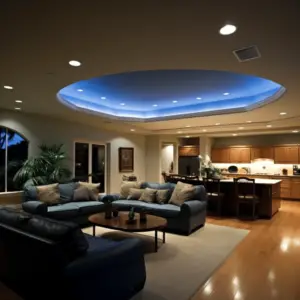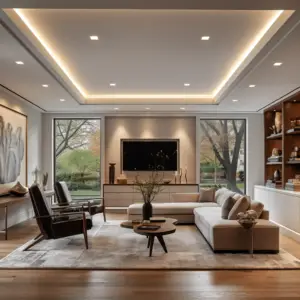Recessed lighting can significantly affect a room’s functionality and aesthetic appeal, whether you’re building a new house or remodeling an old one. A home with recessed lighting has a neat, modern appearance. It may brighten a place, draw attention to particular features like artwork, and make rooms seem and look bigger.
One of the most frequently asked questions about recessed lighting is how to soften recessed lighting. This article will answer that question and walk you through other related topics.
Table of Contents
How Do You Soften Recessed Lighting?

Below are some helpful tips that will help you soften your recessed lighting:
Utilizing Dimmer
Using a dimmer is the most straightforward technique to soften recessed lighting. Most hardware shops sell these gadgets. Connect your recessed lighting to the dimmer, then lower it to the desired level.
Utilizing Filters
You can use filters to soften your recessed lights without changing their appearance or brightness. Many different filters are available, so shop around before deciding. Filters may be affixed to the lights or positioned in front of it.
Changing the Color Temperature
To produce a softer light, you can also alter the color temperature of your recessed lights. A greater color temperature will be brighter and more stimulating, while a lower color temperature will generate a softer and more relaxing light.
Utilizing Low-Wattage Bulbs
Use bulbs with a lower power if you wish to make your recessed lights less bright. This will contribute to producing softer lighting without significantly reducing light output. To change the brightness of your recessed lights, you can also experiment with dimmer switches.
Lighting Covering
Try covering the recessed lights with a cloth or other material if you wish to soften them entirely. This will assist in softening and diffracting the light.
Select the material that best meets your needs from the available options for covering recessed lights.
When to Use Recessed Lighting
Retrofitting ceiling joists with recessed fixtures through wiring holes is possible in new structures or substantial renovations. Ceiling insulation fixtures must be IC house-rated. Non-IC housings don’t need ceiling insulation. Concrete ceilings, complex plasterwork, and delicate molding should not employ recess lighting. Instead, use wall sconces, table lamps, or a chandelier (if the ceiling has an electrical box).
Where to Install Fixtures for Recessed Lighting
For optimal fixture placement and use, pay attention to these suggestions:
- Avoid placing recessed lighting fixtures down the center of the room in rows or too close together. The appearance of this kind of project may resemble an airport runway.
- Your recessed lighting fixtures should be installed as close together as possible for their size. The basic rule is to space 4-inch fixtures at least 4 feet apart and 6-inch fixtures at a distance of roughly 6 feet.Place recessed lighting 12 to 18 inches in front of pictures, bookcases, and drapery panels.
- Reading or job lighting recessed lights should be placed high to avoid head and shoulder obstruction.
- When using recessed lighting, it is more efficient to illuminate a three-dimensional object, such as a sculpture or a fireplace, from two or three distinct angles.
- Use wall-washing recessed lighting fixtures to “push” the walls of a tiny room outward and make the area appear more prominent. You may also direct them to a display of artwork or photographs to draw attention to it.
- Install both under-cabinet lighting and recessed lighting in the ceilings. The light will effectively illuminate your kitchen while washing your countertop in focused light.
Recessed Light Fixture Sizing
The standard sizes are 4-, 5-, or 6-inches in diameter, regardless of whether you select fixtures with fluorescent, standard line voltage, or low voltage halogen fixtures.
The 6-inch lighting is suitable for large entryways and two-story hallways, while the slimmer, contemporary 4-inch lamps are better for smaller spaces with less intrusion.
Extras
Specific effects can be achieved with these specialty fixtures:
- As accent lighting, adjustable recessed light eyeball fixtures can be directed at the artwork.
- Choose recessed wall washer fixtures to cover the walls in light.
- Choose recessed reflectors when you want a fixture to provide the greatest light. You may also install white or black baffle trims to direct light or lessen glare.
Types of Light Bulbs for Recessed Lighting

There are numerous types of fixtures and bulbs available for specific applications when choosing or installing recessed lighting:
- Incandescent bulbs: With the use of reflectors, incandescent bulbs can be used for general lighting or wall washing at a low cost. More modern, energy-efficient lights are being used to replace these.
- LED bulbs: The most energy-efficient lights are light-emitting diode bulbs, which also have a long lifespan. They can also be put in an aperture with a lower diameter.
- Halogen bulbs: These are available in both spot and flood types and produce a pure white light.
- Halogen low voltage bulbs: They have a longer lifespan and produce more light than incandescent bulbs, but they need transformers and unique low voltage housings to operate.
- Compact fluorescent lights (CFLs): Are energy-saving but require a ballast to control the current.
The shape of the bulb also affects the direction in which the light is emitted.
- R (reflector) bulbs: Have a reflective surface incorporated into the back of the bulb to direct all of the light downward.
- BR (bulged reflector) bulbs: Curve to send more light downward.
- APAR (parabolic aluminized reflector) bulbs: Are shaped for tighter beams and used for accent lighting.
- FMR (multifaceted reflector) bulbs: Their inner reflective surfaces have facets that work to produce a focused beam.
